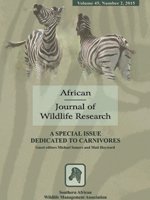In a number of African countries, the trophy hunting of large felids is an important revenue generator for landholders, governments and in some cases communities. The hunting of large felids is especially profitable but they are sensitive to harvest, as the killing of prime-aged, dominant males can lead to infanticide and lowered reproductive success. In an attempt to limit the negative impacts of trophy hunting on large felids, the scientific community has proposed a number of interventions, including age restrictions on the animals that may be hunted. Such interventions are theoretically complementary to trophy hunting, as hunters typically seek large trophies, and older animals are normally larger than younger ones in large felids. If trophy size results in an increase in trophy price, then interventions that improve average trophy size could confer elevated earnings. This is particularly true if such interventions increased the number of failed hunts such that the same tag can be sold more than once. However, if trophy size is not one of the most important factors determining the desirability of a hunt (which we judge by the price paid for a trophy hunt package), it may be more difficult to implement such schemes. It is therefore important to evaluate potential determinants of trophy hunt package price; and we examine that here for leopards (Panthera pardus) in Africa, at both the country and outfitter level. We show that Tanzania and Botswana have the most expensive package prices while South Africa has the cheapest packages. At the country level, we found no statistical relationships between package price and leopard trophy size (either through advertised website or Safari Club International (SCI) leopard trophy size), country GDP, relative hunt success, or quota size. Contrastingly, the number of charismatic species offered within a package and an index of outfitter reputation (as measured by total SCI trophy records) were positively associated with package price. Interestingly, SCI leopard trophy size was inversely correlated with package price. Our results suggest that hunters do not value leopard trophy size above other factors, which could hinder the implementation of more sustainable, age-based leopard hunting regulations.
How to translate text using browser tools
1 September 2015
Rosettes, Remingtons and Reputation: Establishing Potential Determinants of Leopard (Panthera pardus) Trophy Prices Across Africa
Alexander R. Braczkowski,
Guy A. Balme,
Amy Dickman,
David W. Macdonald,
Paul J. Johnson,
Peter A. Lindsey,
Luke T.B. Hunter
ACCESS THE FULL ARTICLE
Africa
economics
leopard
sustainability
trophy hunting





